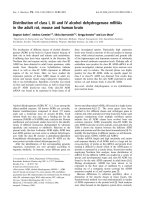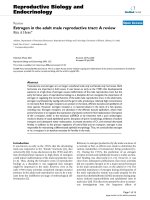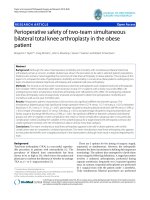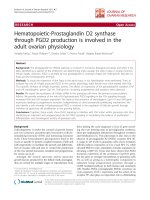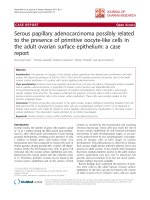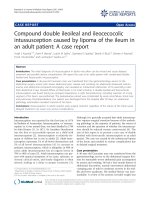2017 ECMO in the adult patient (core critical care)
Bạn đang xem bản rút gọn của tài liệu. Xem và tải ngay bản đầy đủ của tài liệu tại đây (2.81 MB, 169 trang )
E C M O I N T H E A D U LT P A T I E N T
C O R E C R IT IC A L C A R E
SeriesEditor
DrAlainVuylsteke
PapworthHospital
Cambridge,UK
Othertitlesintheseries
Intra-AbdominalHypertensionManuMalbrainandJanDeWaeleISBN9780521149396
ClinicalInformationSystemsinCriticalCareCeciliaMorrison,MatthewR.JonesandJulieBracken
ISBN9780521156745
DeliriuminCriticalCare,SecondEditionValeriePageandE.WesleyElyISBN9781107433656
E C M O I N T HE A D U LT PAT I E N T
AlainVuylsteke,BSc,MA,MD,FRCA,FFICM
ConsultantinIntensiveCareandClinicalDirector
PapworthHospitalCambridge,UK
DanielBrodie,MD
AssociateProfessorofMedicine
ColumbiaUniversityCollegeofPhysiciansandSurgeons
NewYork-PresbyterianHospital
NewYork,NY,USA
AlainCombes,MD,PhD
ProfessorofIntensiveCareMedicine
UniversityofParis,PierreetMarieCurie
SeniorIntensivistattheServicedeRéanimationMédicaleInstitutdeCardiologie
HôpitalPitié-Salpêtrière
Paris,France
Jo-anneFowles,RGN
LeadECMONurse
PapworthHospital
Cambridge,UK
GilesPeek,MD,FRCSCTh,FFICM
ProfessorandChiefofPediatricCardiacSurgery
ECMODirector
TheChildren’sHospitalofMontefiore
NewYork,NY,USA
UniversityPrintingHouse,CambridgeCB28BS,UnitedKingdom
CambridgeUniversityPressispartoftheUniversityofCambridge.
ItfurtherstheUniversity’smissionbydisseminatingknowledgeinthepursuitofeducation,learningandresearchatthehighest
internationallevelsofexcellence.
www.cambridge.org
Informationonthistitle:www.cambridge.org/9781107681248
©AlainVuylsteke,DanielBrodie,AlainCombes,Jo-anneFowles,GilesPeek2017
Thispublicationisincopyright.Subjecttostatutoryexceptionandtotheprovisionsofrelevantcollectivelicensingagreements,no
reproductionofanypartmaytakeplacewithoutthewrittenpermissionofCambridgeUniversityPress.
Firstpublished2017
PrintedintheUnitedKingdombyTJInternationalLtd,Padstow,Cornwall
AcataloguerecordforthispublicationisavailablefromtheBritishLibrary
ISBN978-1-107-68124-8Paperback
CambridgeUniversityPresshasnoresponsibilityforthepersistenceoraccuracyofURLsforexternalorthird-partyinternetwebsites
referredtointhispublication,anddoesnotguaranteethatanycontentonsuchwebsitesis,orwillremain,accurateorappropriate.
Everyefforthasbeenmadeinpreparingthisbooktoprovideaccurateandup-to-dateinformationwhichisinaccordwithaccepted
standardsandpracticeatthetimeofpublication.Althoughcasehistoriesaredrawnfromactualcases,everyefforthasbeenmadeto
disguisetheidentitiesoftheindividualsinvolved.Nevertheless,theauthors,editorsandpublisherscanmakenowarrantiesthatthe
informationcontainedhereinistotallyfreefromerror,notleastbecauseclinicalstandardsareconstantlychangingthroughresearchand
regulation.Theauthors,editorsandpublishersthereforedisclaimallliabilityfordirectorconsequentialdamagesresultingfromtheuseof
materialcontainedinthisbook.Readersarestronglyadvisedtopaycarefulattentiontoinformationprovidedbythemanufacturerofany
drugsorequipmentthattheyplantouse.
Contents
Notefromtheauthors
Listofabbreviations
Apatienttestimony:IsurvivedECMO
1 AbriefhistoryofECMO
2 AnECMOservice
3 TheECMOcircuit
4 MonitoringthepatientonECMO
5 Caseselection
6 Cannulationanddecannulation
7 Coagulation,bloodandECMO
8 Managementofthepatientonveno-venousECMO:generalprinciples
9 Managementofthepatientonveno-arterialECMO:generalprinciples
10 Patienttransfer
11 LiberationfromECMO
12 SpecificsofintensivecaremanagementforthepatientonECMO
13 ExtracorporealcarbondioxideremovalorECCO2R
14 ECMOtosupportorgandonation
15 ECMOregistriesandresearch
Appendix:ThefutureofECMO
Index
Notefromtheauthors
ThisbookisaboutECMOintheadultpatient.Theadultpatientcanbedefinedinmanywaysbutwe
have arbitrarily chosen someone older than 16 years and, more importantly in relation to the discussed
technology,heavierthan20kg.
We would like to acknowledge the contributions of: Dr Mindaugus Balciunas, UK; Dr Richard
Porter,UK;DrMathieuSchmidt,France;andDrMartinBesser,UK.
Abbreviations
ACT
activatedcoagulationtime
AKI
acutekidneyinjury
anti-Xa
anti-factorXa
APR
activatedprothrombintimeratio
aPTT
activatedprothrombintime
ARDS
acuterespiratorydistresssyndrome
CO2
carbondioxide
CPR
cardiopulmonaryresuscitation
CT
computedtomography
DCD
donationaftercardiacdeath
ECCO2R
extracorporealCO2removal
ECMO
extracorporealmembraneoxygenation
ECMONet
InternationalECMONetwork
eCPR
extracorporealcardiopulmonaryresuscitationorECMO-assistedcardiopulmonaryresuscitation
ELSO
ExtracorporealLifeSupportOrganization
FiO2
fractionofinspiredoxygen
HbS
sicklecellhaemoglobin
HIT
heparin-inducedthrombocytopenia
HLA
humanleukocyteantigen
ICU
intensivecareunit
INR
internationalnormalizedratio
LMWH
low-molecular-weightheparin
O2
oxygen
PaCO2
partialpressureofCO2inthearterialblood
PaO2
partialpressureofO2inarterialblood
PEEP
positiveend-expiratorypressure
RRT
renalreplacementtherapy
Apatienttestimony:IsurvivedECMO
Itissomewhatchallengingtodefinewithprecisionwhatcouldfacilitateyourjourneytorecovery,as
thereisnoprecedentinyourlife.Youareintenselysearchingforaninvisiblemarker,adestinationyou
seekbutcannotseeonthehorizon.
Meeting with some of the doctors, nurses and physiotherapists who looked after me was a very
unique and special experience. Being able to put a face to the names I had heard of so often started to
anchormeinthispartofmylifeIcouldnotaccessbefore.Italsoallowedmetosaythankyouinperson,
a pivotal part of the healing process, because I was physically there, unsupported by any machine and
quitewellrecoveredinfact.
Althoughwithoutanyrecollectionofthehospital,IsuspectedthatIhadprobably‘recorded’ many
sounds of intensive care without realizing it. This was confirmed when I was able to hear an ECMO
alarm:thereaction,althoughslowcoming,wasstrong.Thisismyonlymemory,myveryown,andIdo
holditsurprisinglydear.Itisanoddlyreassuringsensationbecauseitactsastheexplanation,ifnotthe
actualvalidation,ofeverythingthathashappenedsince.Italmostgivesalogicalmeaningtothelast30or
somonthsofmylife.
Evenmorenoteworthywastheutterlyinspireddecisiontobringmetothebedofaladyundergoing
ECMO. This was what I very much needed but was too shy to ask for. I felt overwhelmed and a bit
amazed,butIwasnotfrightenedinanyway.ItmademerealizehowfarIhadcome.
Ithasprovedtobeatrulycatharticexperienceforme.Itisvastlyimportanttoencouragepatientsto
return,becauseitisamilestonenotonlyintheirjourneyofhealingbutintheirquestforacceptancetoo.
SomeonetoldmeoncethatIwasbrave;Idonotthinkthisistrue.Youeithersinkorswim.Ididnot
haveachoice,thatisall.Strangely,itmakesthingssimplerandthereforeeasiertogetonwith.
Ialsobelievethatyouneverknowwhatyouarereallycapableofuntilyouarechallengedtoshow
it.Ifyouneverare,youareblessed,truly.
If,however,thediceiscasttheotherway,thereisstilloneoptionleft:
Fightback.Itisworthit.
Chapter1
AbriefhistoryofECMO
◈
Startingpoint
Extracorporealmembraneoxygenation(ECMO)supportisaformofextracorporeallifesupport. ECMO
is not a treatment and does not correct the underlying pathological insult. The technology is a direct
extensionfromcardiopulmonarybypassandtheheart–lungmachineusedincardiacsurgery.
Extracorporeal life support technologies include other devices, such as dialysis, continuous
haemofiltrationandventricularassistdevices
Table 1.1 lists the main events that contributed to the development of ECMO. Early attempts at
mixinggasandbloodwerehinderedbythrombus(bloodclot)formation.Thediscoveryofheparinatthe
start of the 20th century circumvented this obstacle. Various devices to allow mixing of gas and blood
weredeveloped,withthebubbleoxygenatorprobablythemostrecognized.Inthissystem,thegasliterally
bubbled up in the blood. Great attention to the size of the bubbles and the circuit design with traps
allowedthistohappenwithouttheairbubblesbeingentrainedintothepatient’sbloodstreamandcausing
anairembolism.Themixingofgasandbloodcausedmultipledisruptionstothebloodhomeostasisand
limitedthedurationofexchange.Interposingasemi-permeablemembranebetweentheairandtheblood
wasakeydevelopmentthatallowedlongerperiodsofsupport.
Table1.1MilestonesinthehistoryofECMOsupport
Year
Event
1635–1703
RobertHookeconceptualizesthenotion
ofanoxygenator.
1869
LudwigandSchmidtattemptto
oxygenatebloodbyshakingtogether
defibrinatedbloodwithairina
balloon.
1882
vonSchröderofStrasburgusesa
bubbleoxygenatortooxygenatean
isolatedkidney.
1882
FreyandGruberdescribethefirst
‘two-dimensional’,direct-contact
extracorporealoxygenator,which
exposedathinfilmofbloodtoairinan
inclinedcylinder,whichwasrotatedby
anelectricmotor.
1916
DiscoveryofheparinwhenJay
Macleandemonstratesthata
phosphatideextractedfromcanineheart
musclepreventscoagulationofthe
blood.
1929
Firstwhole-bodyextracorporeal
perfusionofadogbyBrukhonenkoand
Tchetchuline.
1930s
GibbonandKirklandfurtherdevelop
theconceptoftheoxygenator.
1948
Bjorkdescribestherotatingdisc
oxygenator.
1952
All-glassbubbleoxygenatorbyClarke,
GollanandGupta.
1953
Firstsuccessfulhumanintracardiac
operationunderdirectvisionusinga
mechanicalextracorporealpump
oxygenator.
1955
KirklinandcolleaguesattheMayo
ClinicfurtherdevelopedtheGibbontypestationaryscreenoxygenatorinto
theMayo–Gibbonpumpoxygenator
apparatus,andmadeitavailablefor
commercialuse.
1955
Lilleheiandcolleaguesthenbeginto
usetheDeWallbubbleoxygenator
clinically.
1958
Clowes,HopkinsandNevilleuse
25m2ofpermeableethylcellulose
(soonreplacedbythemechanically
strongerpolytetrafluoroethyleneor
Teflon)inmultiplesandwichedlayers
toformthefirstclinicalmembrane
oxygenator.
1972
Hillreportsthefirstadultsurvivoron
ECMO.
1972
EditorialintheNewEnglandJournal
ofMedicinebyZapol:‘Buyingtime
withartificiallungs’.
1976
Bartlettreportsthesuccessfuluseof
ECMOonanabandonednewborn
nicknamedEsperanzabythenursing
staff.
1978
KolobowandGattinonidescribeusing
extracorporealcirculationtoremove
carbondioxide,allowingapotential
decreaseinventilationharm.
1979
Publicationofarandomizedcontrolled
trialinadultpatientswithacute
respiratorydistresssyndrome(ARDS)
bytheNationalHeart,LungandBlood
Institute:disappointingresultswith
10%survivalineithergroup.
1989
FoundingoftheExtracorporealLife
SupportOrganization(ELSO).
2009
H1N1influenzapandemicanddata
relatingtoclinicalsuccesswithECMO
arewidelydisseminated,includingin
thelaypress.
2009
‘Efficacyandeconomicassessmentof
conventionalventilatorysupportversus
extracorporealmembraneoxygenation
forsevereadultrespiratoryfailure
(CESAR):amulticentrerandomized
controlledtrial’,publishedinThe
Lancet.
2011
TheNationalHealthService(England)
commissionanationalrespiratory
ECMOservice.
2014
Publicationof‘Positionpaperforthe
organizationofextracorporeal
membraneoxygenationprogramsfor
acuterespiratoryfailureinadult
patients’intheAmericanJournalof
RespiratoryandCriticalCare
Medicine.
The birth of ECMO can be traced back to 1929 in Russia with the first successful reported
extracorporealperfusionofadog.Inhumans,thefirstsuccessfulcardiopulmonarybypasswasperformed
in1953byGibbon.
In1971,atraumapatientsurvivedafterbeingsupportedfor3dayswithECMO.Heisconsideredto
be the first patient to benefit from the technology. A few years later, Robert Bartlett reported the first
infanttobenefitfromECMOsupport.Manyclinicianswerethenenthusedbythetechnologyandofferedit
totheirpatients.
Inthebeginning
A first trial of extracorporeal support in patients with respiratory failure was initiated by the National
Heart,LungandBloodInstituteintheUSA.Theresults,publishedin1979,wereverydisappointingwith
most patients (90%) dying and with no difference between the groups. The authors acknowledged that
ECMOwasabletosupportpatientsbutsuggestedthatitdidnotstopthelungsdeterioratingprogressively
withnorecovery.
Asaresult,mostcliniciansstoppedofferingECMO.
A minority continued to improve the technique. Others worked on modifying other aspects of the
support of respiratory failure patients. Clinicians understood that lungs were being damaged by
mechanical ventilation with positive pressure. Methods to decrease this mechanical insult were
developed.Theso-calledprotectiveventilationstrategiesareinfacttheleast-damaginglungventilation
techniques. One promising method was to combine therapies using ECMO to remove carbon dioxide
(CO2)toreducetheamountofventilationrequiredwithmechanicalventilation.However,therewasno
evidenceincomparativestudiesthatusingECMOledtobetteroutcomesthanconventionaltherapy.
CliniciansusingECMOtosupportinfantswereconvincedthattheyweresavinglives,andseveral
trialsandcaseseriesprovedthistobecorrect.PaediatricECMOdevelopedandwasembracedbymany.
Paediatric centres continued to accumulate expertise and experience. But this book is about the adult
patient…
Enthusiast clinicians teamed together and founded the Extracorporeal Life Support Organization
(ELSO) in 1989, justified mainly by the successes observed in paediatric support. This network
understood the importance of sharing practice and collecting data from all participating centres. Data
aboutpaediatricandadultECMOwereprogressivelyaccumulatedtoinformpracticearoundtheworld.
Movingforward
Atthebeginningofthe21stcentury,technologyhadadvancedwiththedevelopmentandoptimizationof
devices used in cardiopulmonary bypass. The bubble oxygenator had long been forgotten and the
membraneoxygenatorwasbeingusedbyall(allowingseparationofbloodandgasbyasemi-permeable
membrane). This, combined with the advent of centrifugal pumps, improved the biocompatibility of the
whole process. Although still not harmless, the technique was becoming simpler. Improved design
removedmanymechanicalissues.Theintroductionofsmaller,less-intrusivecircuitsallowedportability.
The changes were such that this era can be referred to as the start of the next generation of ECMO
(informallycalledECMOv2.0).
Specialist centres had started using ECMO in specific patients, such as after lung transplantation.
Others were exploring ECMO to support the heart and lungs. The technique was confined to highly
specializedcentresandtheoccasionalpatient.
In2009,whenconfrontedwithanewsubtypeofinfluenzavirus(H1N1)thattargetedmainlyyoung
people,theclinicalcommunityusedECMOwithsuccesstosupportmanypatientstofullrecovery.While
itisquestionablethatECMOmadeadifferenceinoutcome(someareconvinceditdid,butthedatahave
beenthesubjectofmanydebates),thisexperienceledtoawidespreaduseofthepractice.Noteworthy
wasthefactthatECMOwasofferedtoalargenumberofverysickpatientsduringthepandemic,without
modernhealthservicesimploding,albeitstretchingavailableresources.
Simultaneoustothepandemic,theresultsofalargeprospectivetrialoftheuseofECMOinpatients
with acute respiratory distress syndrome (ARDS) was published in The Lancet (the CESAR trial) and
fuelled both the controversy about and the use of the technology. This trial showed that transferring
patientswithARDStoaspecialistcentrethatcouldofferECMOifrequiredledtoabetteroutcome.It
didnotshowthatECMOitselfhelped.
Asaresultofthepandemic,andsupportedbythepublishedevidence,cliniciansstartedtoconsider
ECMOearlierandmanyprovidersstartedtoofferit.Somecountriessetupnational networks (e.g. the
specifications of the National Health Service (England) national respiratory ECMO service can be
accessedonline;seeChapter2).
Parallel to the development of ECMO to support respiratory function, ECMO has been used to
support patients with cardiopulmonary failure. In this setting, ECMO can be seen as a way to provide
cardiopulmonarybypasseitherrapidly(suchasinacardiacarrestsituation)orforseveraldays(suchas
whencontinuingcardiopulmonarybypassaftercardiacsurgery).Caseseries(andnumerouscasereports)
aresupportingthedevelopmentofveno-arterialECMOasawaytosupplymostorganswithacontinuous
oxygenated blood supply. This support is being used in an increasing number of patients, based on
clinicians’beliefthatithelpsonsomeoccasions.However,scientificevidenceislacking.
Keypoints
Thisisabookaboutadultpatients.
ECMOcircuitsarenowsimplerandsafer.
ECMOsavedlivesduringtheH1N1influenzapandemic.
ECMOisasupportmodalityandnotatreatment.
Tolearnmore
GattinoniL,PesentiA,MascheroniD,etal.(1986).Low-frequencypositive-pressureventilationwith
extracorporealCO2removalinsevereacuterespiratoryfailure.JournaloftheAmericanMedical
Association,256,881–6.
LimMW.(2006).Thehistoryofextracorporealoxygenators.Anaesthesia,61,984–95.
NoahMA,PeekGJ,FinneySJ,etal.(2011).Referraltoanextracorporealmembraneoxygenationcenter
andmortalityamongpatientswithsevere2009influenzaA(H1N1).JournaloftheAmericanMedical
Association,306,1659–68.
PeekGJ,MugfordM,TiruvoipatiR,etal.(2009).Efficacyandeconomicassessmentofconventional
ventilatorysupportversusextracorporealmembraneoxygenationforsevereadultrespiratoryfailure
(CESAR):amulticentrerandomisedcontrolledtrial.Lancet,374,1351–63.
Chapter2
AnECMOservice
◈
Staffing
An ECMO service is entirely dependent on its people. The team is organized to provide a continuous
service,24haday.Table2.1providesanexampleofalistofthekeymembersoftheteam.Thiswill
varyfromcentretocentre,dependingonlocalandnationalorganizationalfactors.
Table2.1ExampleofalistofkeymembersoftheECMOservice
Title
Role
Leadclinician(ECMO
director)
OverallresponsibilityfortheECMOservice.Mustpracticeintensive
caremedicinebutcanbefromavarietyofbackgrounds.
Attendingclinicians
Round-the-clockmanagementofthepatient.Thesewillusuallybea
mixofpost-andpre-certificationdoctors.
Attendingsurgeons
Immediatecardiothoracicandvascularsurgicalsupport,whichis
requiredroundtheclock.
ECMOcoordinator
Tocoordinatereferralsandretrievals.Ensuresmultidisciplinary
educationandtrainingrequirementsareachieved.Developsand
reviewsprotocolsandguidelines.
ECMOspecialists
Staffwhohaveundergonespecialisttrainingandhaveexpert
knowledgeofthemanagementoftheECMOpatientandtheECMO
circuit.WillsupporttheECMOcoordinatorinday-to-daycoordination
oftheservice.
Attendingnurses
Day-to-daypatientcareandbedsidemonitoring.Theyareexperienced
intensivecareunitnurseswhohaveundergoneadditionaltrainingin
caringforthepatientonECMO.Theywillbesupportedbyheathcare
supportworkers.
Leadperfusionist
PerfusionistwithspecialistECMOknowledgewhosupportsthe
ECMOcoordinatorinmeetingeducationalandtrainingrequirements.
Clinicalperfusionists
ProvidetechnicalsupportinrelationtotheECMOcircuit.
Physiotherapists
Provideday-to-dayrehabilitationinput.
Pharmacists
Provideday-to-daypharmacyinput.Willseekpertinentandupdated
informationinrelationtothepharmacokineticsofdrugsusedinthe
ECMOpatients.
Dieticians
Provideday-to-daydieteticinput.
ECMOsecretary
TosupportnumerousadministrativetasksrelatedtotheECMOservice.
Clinicaldataanalyst
Collectionandanalysisofdata,whichisimportanttodevelopastrong
service.Thisallowssubmissiontotheinternationalregistry.
Otherspecialitiesinvolved
inthegreater
multidisciplinaryteam
Radiologists,haematologists,microbiologists,virologists,biochemists,
bloodbankspecialists,cardiologists,respiratoryphysicians,
neurologists,nephrologists,obstetricians,gynaecologists,clinical
psychologists,psychiatrists,orthopaedicandtraumasurgeons,
ophthalmologists,ear–nose–throat(ENT)specialistsandpalliative
careclinicians.
Ancillarystaff
Kitchenstaff,cleaners,porters,drivers,switchboardoperators,
accountantsandtechnicalsupport.
AllmembersoftheteamrequirespecialistknowledgeinmanagingtheECMOpatient,andarobust
teaching programme should be established. The volume of activity of a centre should be sufficient to
allow availability of the required resources for training. Staff training should be mandatory. Regular
refreshersshouldbeprovidedandcompetenciesregularlyassessed.Table2.2liststhetopicsthattheinhousetrainingprogrammeshouldcover.TheELSOprovidesregularlyupdatedguidelinesandresources
forthetrainingandcontinuouseducationoftheECMOspecialist.
Table2.2SpecializedtopicstobecoveredinthetrainingofanECMOclinician
TypesofECMO
RiskandpotentialbenefitsofECMO
IndicationandcontraindicationforECMO
PathophysiologyofthepatientonECMO
ECMOequipment(includingcircuits)
GasexchangeonECMO
ECMOemergencies
InsertingECMO:Why?When?How?
LiberationfromECMO:Why?When?How?
CoagulationmanagementwhileonECMO
Thepost-ECMOpatient:immediateandlongterm
ComplicationsofECMO
CostofECMO
TransferofthepatientonECMO
The team of educators must be allocated time and resources to attend state-of-the-art conferences.
Educators can then ensure their local programme is up to date. Training should include regular water
drills, during which a primed circuit is used without being connected to a patient. This allows
familiarizationwiththeequipmentandidentificationofpotentialissues.Staffaretrainedtorecognizeand
managespecificECMOemergencies,andthendoitagainandagain.
A list of competencies expected from each role for clinicians involved in the management of the
patientonECMOisuseful.Thesecanbedevelopedatthelocalornationallevel,andtheELSOprovides
examplesandready-to-uselists.
Multidisciplinarymeetingsshouldbescheduledonaregularbasisandnewlyacquiredknowledge
andexperiencesharedtoensurethewholeteamcontinuestolearnandevolve.
Doctors
Doctors looking after ECMO patients will require multiple skills. The ideal ECMOlogist would be a
surgeon, intensivist, chest physician and anaesthesiologist combined. This person should have acquired
the skills of many different specialities. As this is rather unusual, a good ECMOlogist will be a
‘connexist’, i.e. someone who can recognize his/her own limitations and call on others’ expertise. The
closesttothisidealareintensivecaredoctorsastheyareusuallyworkinginthismanner.
ThestartingpointforanydoctorwishingtolearnECMOisathoroughunderstandingoftheECMO
circuititself(seeChapter3).Thesecondkeyclinicalskilltoacquireishowtoselecttherightpatients,
i.e. patients requiring support while recovering from a reversible insult or eligible for another type of
long-termsupport(seeChapter5).
TheECMOcommunityhasagreattraditionofsupportingeachother.Thesedays,multiplecourses
areavailabletoteachthebasicsofECMO.CliniciansinvolvedinECMOarealwayswillingtohelpeach
other.
AdultintensivecareskillsarecentraltothesafedeliveryofECMO,andallthebasicsofintensive
caremanagementshouldbeadheredto.
ECMOisacompletesystemofcare,notjustabolt-onaccessory.
JuniordoctorsshouldbeinvolvedinallaspectsofthecareofECMOpatients.Thefirstskillthey
willneedtoacquireistorecognizetheirlimitationsandwhentocallforhelp.
ECMOspecialist
TheECMOspecialisthasakeyrole.Theyareimmediatelyavailableintheclinicalareaandarethefirst
linebetweenECMOandthepatient.Theyrequireadvancedskillstoensurenoharmcomestothepatient.
They are the first line in managing the patient and circuit emergencies and, in addition to excellent
technicalskills,shouldhaveeffectivecommunicationskillsandtheabilitytoworkinstressfulsituations.
The ECMO specialist will be skilled in the care of patients on ECMO, and should have a strong
intensivecarebackground.
The ECMO specialist must achieve competency through completing the necessary training and
assessment. Practical skill sessions concentrate on circuit surveillance, troubleshooting and emergency
procedures. Emergency procedures such as air embolus removal are practised repeatedly to ensure
competency.
TheECMOspecialistcanundertakeotherroles,suchasensuringappropriateanticoagulation,and
titratingECMOflowandgastoensureadequatelevelsofcardiacand/orrespiratorysupport.
ECMO specialists can be nurses who have undergone additional training, or can come from other
specialities,suchasperfusionormedicalbackgrounds.
AllnursescaringfortheECMOpatientmusthavebasicskillsspecifictoboththeintensivecareunit
(ICU)andtheECMOpatient.Theymustbeabletoactimmediatelyinacaseofacatastrophicfailureof
theECMOcircuit.AnECMOcircuitmustneverbeleftinthehandsofapractitionerwhoisnotqualified
tolookafterit.
ECMOcoordinator
TheECMOcoordinatorusuallyreferstoahighlyexperiencedECMOspecialistwithclinical,educational
and managerial responsibility for the ECMO programme. This person may be supported by deputy
coordinators and shift leaders who are experienced ECMO specialists to ensure round-the-clock
availability.TheyareinvolvedinthedevelopmentofallECMO-relatedprotocols.
This coordination is an essential part of ensuring the safety of the patient on ECMO. It ensures
communicationbetweenteammembersandsmoothmanagementofpatientreferral,transport,cannulation
andongoingcare.
ECMOdirector
The ECMO director is an ECMO clinician nominated to have overall managerial and clinical
responsibilityfortheECMOprogramme.TheECMOdirectordoesnotneedtodictatethecareofeach
patientbutleadsateamtodeliverthebestpossiblecare.
Perfusionist
Perfusionists are experts in the management of extracorporeal circuits, and their main expertise is with
short-term cardiopulmonary bypass used in the operating theatre. A perfusionist will need additional
trainingtogaintheknowledgerequiredtomanagetheECMOcircuit.
PerfusionistsareanintegralandimportantpartofmanyECMOprogrammes.Itisusualpracticein
some institutions for a perfusionist to prime the ECMO circuit and initiate ECMO before handing
management of the circuit over to the ECMO specialist. Once the patient is returned to the ICU and
establishedonECMO,theperfusionist’sroleincludescircuitorcomponentreplacementandtransportof
thepatienttootherareasofthehospital,suchasthecatheterlaboratoryorthecomputedtomography(CT)
scanner.
AperfusionistwhohasdevelopedaspecialinterestinECMOcanactastheleadofallperfusionists
inaninstitutionandshouldensurethatknowledgeandgoodpracticeareshared.
Perfusionists should be involved in circuit design and modifications, management of ordering and
stocklevels,equipmentmaintenanceanddevelopmentofprotocols.
